University community welcomes President Wintersteen
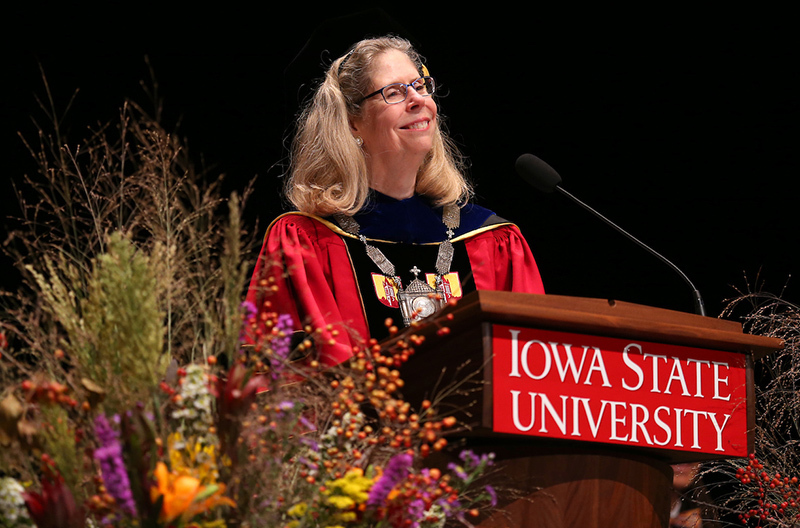
President Wendy Wintersteen acknowledges applause after she is installed as Iowa State's 16th president Sept. 21. Photos by Christopher Gannon.
Infusing an Iowa State education with entrepreneurism, recognizing and rewarding excellent faculty and staff, innovating to become a more efficient enterprise and improving the student experience in every college are among the items on President Wendy Wintersteen's to-do list. But above all, she promised to work hard to make Iowa State a model of inclusivity among colleges and universities.
Wintersteen laid out the goals of her presidency during the Sept. 21 installation ceremony in Stephens Auditorium. Her speech referenced numerous milestones in Iowa State history as well as her history at Iowa State.
Noting that she is a product -- as extension staffer, doctoral student, faculty member, college administrator and now president -- of a university with inclusiveness "built into its DNA," Wintersteen pledged to "nurture this ideal and energize it for all those who come after me. It is one of my top priorities."
Catch up
She praised the university's founders as practical idealists for opening higher education to all races, genders and classes, at a time when just four colleges permitted equal admission to women.
"My passion for Iowa State continues after these 39 years because I know how it transformed me," she said.
Entrepreneurs
Wintersteen said she wants "a spirit of entrepreneurism" to become a significant component of the Iowa State brand.
"I intend to establish a vibrant entrepreneurial ecosystem where innovating is built into the curriculum, and where innovations and entrepreneurial ideas come from our students, faculty and staff, and they receive appropriate support to move these ideas forward."
Borrowing from successful degree programs in the Ivy College of Business, Wintersteen talked about building undergraduate entrepreneurial programs in the other colleges that help prepare students for an economy of rapid change.
To have an impact, she said Iowa State must both recognize and support innovation. She said she will assist with "the next step" for faculty, staff and students, for example, patents licensed to industry or business startups.
Supporting faculty, staff and students
Wintersteen said she "will make it a priority to recruit, nurture and retain excellent faculty." That will take additional funding for state-of-the-art facilities, graduate assistants and research programs. The goal, she said, should be nationally ranked departments in each college.
Noting the university's rapid enrollment growth over the last decade, Wintersteen said it's critical to "provide the tools and resources that enable our faculty and advisers to touch and inspire all of our students."
"As ISU reaches for greater heights, I will reward the excellence of our teachers and the success they achieve in the classroom," she said.
She also wants to increase the number of students whose education includes "high-impact" learning experiences such as extended field trips and studies abroad, and to find new ways to improve graduation rates. She pledged to work with ISU Foundation professionals to raise more dollars for completion grants -- university funds awarded to undergraduates within a semester of completing a degree "to get our seniors across the finish line."
Innovating for excellence
But in the current higher education funding environment, Wintersteen said innovation needs to be part of the ticket to excellence, and she said her administrative team is committed to constant innovation. Examples of what that could look like are:
- Improving the university's administrative efficiency
- "Pruning away" less efficient programs or initiatives to invest in more productive ones
In addition, she pledged to identify government partnerships, public-private partnerships, and global and venture capital partnerships "to grow this great university and achieve our fullest potential."
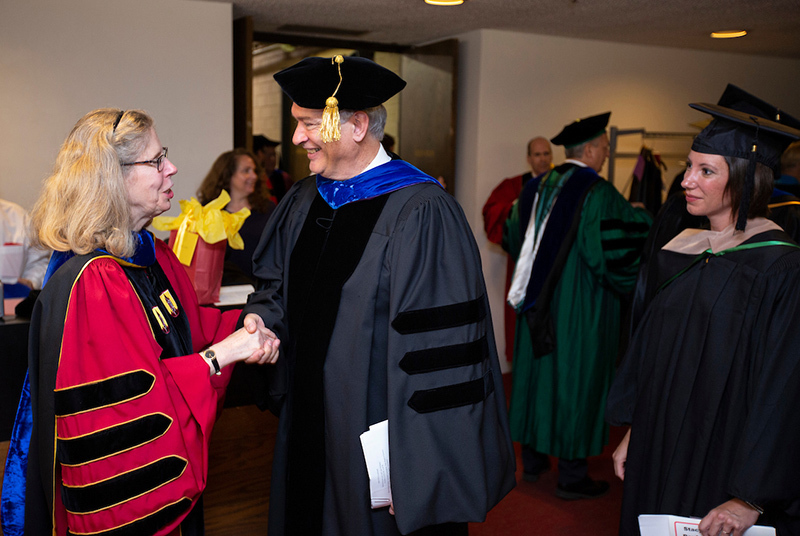
President Wendy Wintersteen greets Faculty Senate president Peter Martin and P&S Council president Stacy Renfro prior to the installation ceremony Sept. 21.
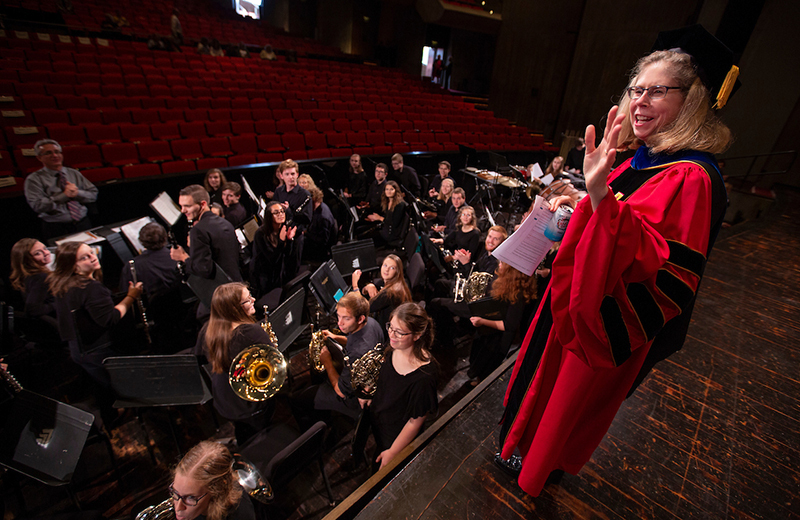
President Wendy Wintersteen greets members of the ISU Wind Ensemble as it prepares for the installation ceremony's prelude concert.
How installation speakers celebrated Wintersteen
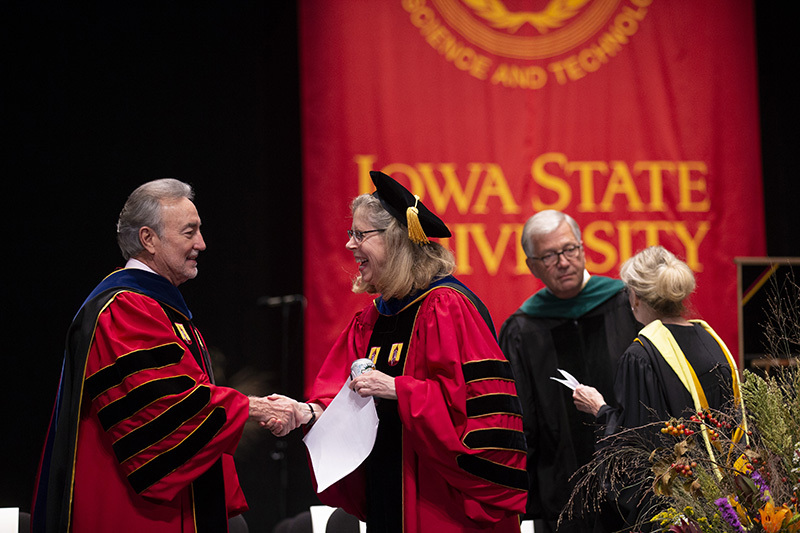
Former President Gregory Geoffroy greets President Wendy Wintersteen before her installation ceremony at Stephens Auditorium Sept. 21. Photo by Christopher Gannon.
Former President Gregory Geoffroy called some old friends at Iowa State looking for choice anecdotes about President Wendy Wintersteen to sprinkle in his introduction of her at her Sept. 21 installation ceremony -- quirks, funny stories, tidbits that would surprise a campus where she has worked for four decades.
"But alas, I learned very little," said Geoffroy, who served as Iowa State's president from 2001 to 2012. "President Wintersteen is really a straight arrow."
Instead, Iowa State's 14th president heard what he already knew about its 16th, who he appointed to lead the College of Agriculture and Life Sciences in 2006 and encouraged to seek the presidency when he retired. Geoffroy said colleagues described Wintersteen as hard-working and thoughtful, a sincere listener who is disarming and humble, yet cordially decisive.
"She has a way of telling you 'no' and somehow making you feel really good about the decision when you leave her office," Geoffroy recalled Distinguished Professor in Agriculture and Life Sciences Max Rothchild telling him.
Noting Wintersteen's reputation for frugality, Geoffroy pointed out she'd named her cats Penny and Nickel.
"Quarter and Dime were just too rich," he joked.
Wintersteen's tenure at Iowa State includes time as an extension staff member, graduate student and faculty member before rising through the administrative ranks. The love she has for the institution is clear, Geoffroy said. The university is fortunate to have her leadership, which is ideally suited for the challenges at hand, he said.
"President Wintersteen is exactly the right person to be at the helm of Iowa State at this time in its history," Geoffroy said.
Geoffroy was one of several speakers to offer greetings or remarks during the ceremony. Here are highlights from what others said about Wintersteen:
Gov. Kim Reynolds
"Your compassion and concern for others is contagious. You've made a tremendous difference for students, faculty and staff for nearly 40 years at Iowa State University. Moving forward, I have no doubt your influence will continue to serve as a catalyst for improving people's lives."
State Board of Regents president Michael Richards
"The day I announced that Dr. Wintersteen would be the Iowa State's 16th president, and its first woman president, will always be a highlight of my own presidency as well as for many of my fellow regents."
Student Government president Julian Neely
"In the time that we have worked together, I have recognized the passion you have for improving the student experience and reminding us that students are the heart of this university."
Faculty Senate president Peter Martin
"President Wintersteen, you are, and you have been for a long time, one of us."
Feedback sought on proposed service delivery models
Improved service delivery
For more than six months, a campus team has been developing ways to improve service delivery -- specifically, how day-to-day finance and human resources functions get done and who is doing that work. In a Sept. 24 email to employees, President Wendy Wintersteen said the team is ready for input on its proposed models for service delivery in both areas.
The Institutional Effectiveness Leadership Team (IELT), co-chaired by College of Liberal Arts and Sciences dean Beate Schmittmann and vice president for research Sarah Nusser, developed the proposed service delivery models after studying best practices at other institutions. The team worked closely with campus leaders and WorkCyte consultants to design service delivery models that take advantage of efficiencies provided by enterprise software platforms, especially Workday.
"We are moving at a pretty quick pace to present the proposed models to the campus community because many of the roles specified in the new Workday system connect to people who would serve in improved service delivery staff roles," Schmittman said. "It will be important to establish these roles and the employees who might fill them so that formal Workday training can begin in the spring. The goal is to have well-trained staff who can leverage new technology capabilities like Workday and enhance our culture of quality, responsiveness, accountability and excellent customer service."
The proposed models restructure who is tasked with financial transactions and human resources processes, such as reporting travel expenses, ordering supplies, accessing payroll information and hiring personnel.
Gathering feedback
Schmittmann and Nusser have scheduled about a dozen October presentations about the proposed service delivery models with campus groups and stakeholders to solicit their input. A pair of town hall meetings also are planned:
- Oct. 10, 9-10:30 a.m., MU Cardinal Room
- Oct. 11, noon-1:30 p.m., MU Pioneer Room
Both sessions will be livestreamed. Attendees are encouraged to bring questions and feedback. An online form is available for feedback submissions.
The IELT and its partners will use the feedback to finalize the service delivery models. Implementation for the finance and human resources models will go hand-in-hand with Workday's July 1 go-live date. Service delivery models for other administrative functions likely will follow as needs are identified.
"From our early discussions with campus leaders, we are learning a great deal about how to craft models that improve our effectiveness and serve Iowa State's missions," Nusser said. "We expect to learn even more as we continue broader outreach, and we hope these discussions inform future projects to improve the effectiveness of administrative services."
Getting copyright right in the classroom
Determining how to legally use copyrighted materials in teaching often yields an unsatisfying answer: It depends.
"It kind of comes down to reading the fine print," said Barbara Biederman, associate counsel in the office of university counsel. "Copyright is a very fact-specific kind of matter."
To help navigate copyright issues in the classroom, Biederman and Abbey Elder, open access and scholarly communication librarian, held a hands-on workshop earlier this month. Here are some tips culled from their workshop, a quick guide they provided participants and online resources recommended by the library.
Link when you can
When sharing readings or other copyrighted content without permission, the safest move is providing an online link to an original source or the library. That avoids infringing on a creator's rights to determine how their work is used, reproduced, distributed, adapted or displayed.
"Linking is always the best practice," Biederman said.
Even for journals the library subscribes to, providing students a link is better than a printed copy or an uploaded PDF because it gives the library, and the copyright holders, more accurate usage data, Elder said.
What about classroom use?
Copyright law includes an exemption for classroom use, which allows for displaying or performing copyrighted work but not distributing or reproducing it. The material must be presented in a classroom setting for face-to-face instruction at a nonprofit institution.
The federal TEACH Act provides similar protection for displaying or performing copyrighted work in online courses but with far more strings attached. For instance, content can't be designed for online educational use and must be presented in a time-limited format designed to prevent students from downloading it.
For online courses, it's often easier to use a fair-use exemption than the TEACH Act, Elder said.
Fair use
There are no simple rules to follow in deciding whether sharing copyrighted material without permission qualifies under the wide-ranging and essential exception to copyright law known as "fair use." Claiming a fair-use exemption requires balancing four factors, a subjective endeavor that's spurred mountains of court cases.
"They're all weighted equally. You have to do a holistic evaluation of that," Biederman said.
The factors to consider:
- Purpose and nature of use If you're using the content for teaching, research, scholarship, journalism or criticism, or to transform it into something new, that favors fair use. Commercial uses count against.
- Nature of original Work that's published is more likely to be fair use than unpublished work. Nonfiction weighs on the fair use side, creative work weighs against.
- Amount of original used Using less of an original, an appropriate amount for the educational purpose, makes it more likely to be fair use. Using the entire work isn't allowed.
- Effect on original If the use would deprive the copyright holder of income, that's a strike against fair use.
Create and retain a written record of your analysis, and consider consulting with colleagues or the experts in the university counsel's office or library. Keep in mind that using material for an educational purpose doesn't on its own qualify as a fair use.
No worries
Copyright concerns can be avoided, of course, by getting permission to use copyrighted work. The permission should be in writing and explicit about the uses granted and for how long.
In addition, work that is in the public domain can be used and shared freely by anyone. That includes ideas and facts, government documents, work published prior to 1923 or by a creator dead for at least 70 years, and material assigned the Creative Commons license CC-0. (Other Creative Commons licenses may allow for more limited uses, as well.)
However, be careful in assuming material is public domain because it is labeled that way online. The designation could be incorrect.
"You need to question where your sources are coming from," Elder said.
There's help
Copyright holders can and do seek out potentially improper uses to demand royalties they believe they're due, Biederman said.
"Unfortunately, or fortunately, the more you learn about copyright, the less comfortable you might feel in the decisions you're making," she said.
But Iowa State employees aren't personally at risk if they're not negligent or violating the law intentionally, Biederman said.
"As long as you're using due diligence, I wouldn't let that paralyze you as much as it probably seems like it should," she said.
Elder and Biederman encouraged anyone struggling with a copyright question to ask them for help.
"We're not going to just tell you, 'No, that's illegal.' We're going to help you work through how to actually use something," Elder said.
Elder can be reached at 294-5753 or aelder@iastate.edu. Biederman can be reached at 294-0147 or barbara@iastate.edu.
Design's secret supply source
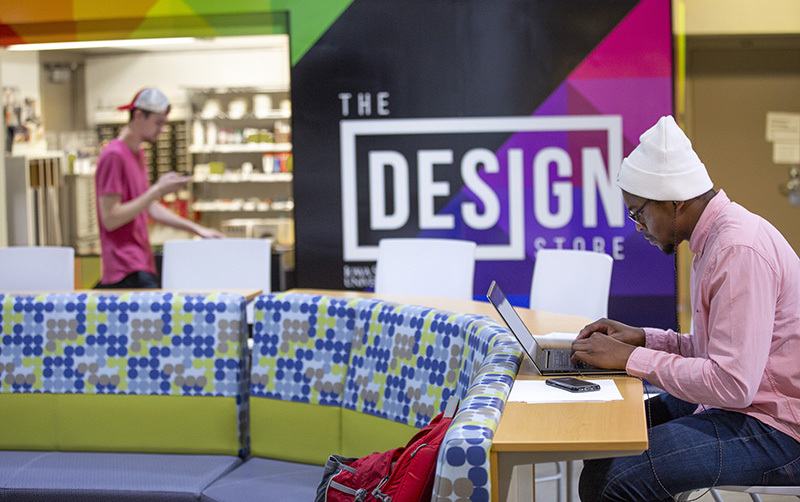
Photos by Christopher Gannon.
Did you know the ISU Book Store has a satellite location at the College of Design? A renovation of the space may help with awareness, adding color and visibility to its second-floor location. Senior graphic design student Mikah Fitzgerald created the new look for its exterior walls.
The Design Store, open since the mid-1990s, offers a range of basic supplies -- for example, pens, pencils, sketch pads, adhesives, foam board, poster board and paper. Lots and lots of professional-grade paper. Caroline Christie, a senior marketing major who works at the store, said business is steady throughout the day and especially between classes. The most popular item? In her opinion, it's mat boards.
The location is open 8:30 a.m. to 5 p.m. Monday through Thursday when classes meet, and closed during summer and the first week of the fall and spring semesters. Students can charge items to their U-Bill, and anyone can make a purchase with a credit or debit card. The Design Store is on the second floor, near the atrium's open staircase and elevator.
Guidelines for a partial closing during winter break
Iowa State leaders last week shared guidelines for a partial campus closing during the winter break. The university will reduce services Monday, Dec. 24, through Tuesday, Jan. 1, when many external organizations and businesses also will operate at reduced levels.
Three university holidays fall during this window: Dec. 24-25 and Jan. 1, as does the Dec. 29-30 weekend. When the Dec. 22-23 weekend is factored in, it leaves four work days -- Dec. 26, 27, 28 and 31 -- for which deans, vice presidents and senior vice presidents are encouraged to allow employees to use available leave when it works with scheduled events and work priorities.
The combination of weekends, holidays and leave days creates up to an 11-day winter break for employees. Energy savings, where building thermostats can be adjusted for significant time periods, is another goal of the partial closing.
What to do now
In their memo to administrative officers, interim senior vice president Pam Cain (finance, university services) and interim vice president Kristi Darr (university human resources) noted the closing is not mandatory. They wrote that critical services, maintenance and research can continue, but many services will be reduced to weekend or holiday levels.
Units should share their plans in advance with the appropriate dean, vice president or senior vice president. Offices that close must have procedures in place to handle incoming messages (phone or email) and emergencies. By the first week of November, units are encouraged to share any partial closing plans with staff and post them on their websites so that students, customers and staff can make plans.
During winter break
Offices should include their reduced office hours and emergency contact information in voice message and on websites.
Facilities staff and police officers will work during the partial closing, but they can't monitor the entire campus at all times. Trouble calls can be made to facilities planning and management, 294-5100, or the public safety department, 294-4428.
Cain and Darr referred administrators and supervisors to two documents for more information:
- Staffing guidance for university breaks
- Frequently asked questions: University breaks
Staffing questions may be directed to HR liaisons or university human resources, 294-4800.
Theatre program focuses on collaboration
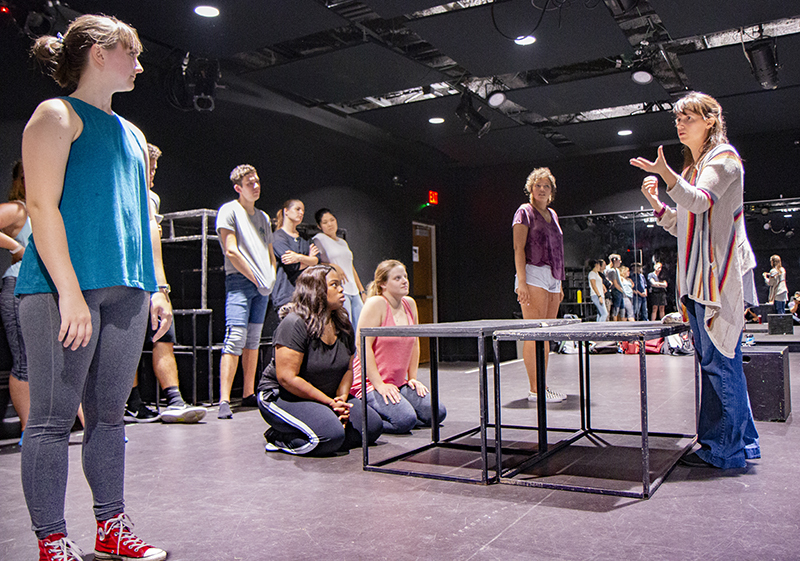
Director Amanda Petefish-Schrag, right, works with the cast during a rehearsal of the theatre program's season-opening production, "This Is Not a Pipe Dream." Students pictured, from left to right, are Alyson O’Hara, Nathan Krusemark, Joi Wright, Amanda Gray, April Tan, Emily Heckle and Kiera McGregor. Photo by Keo Pierron.
The theatre program opens its season this week with "This is Not A Pipe Dream," the first of six productions in 2018-19. With the new season comes a collaborative initiative that's part of the program's revised mission.
"We are reframing our mission to empower citizen artistry, which is all about being a human who is celebrating their artistry, but also being an engaged and active member of the community," said Brad Dell, director of the theatre program. "The CoLab Initiative is a signature example of this new mission, and we're really excited about heading in this new direction."
ISU Theatre's CoLab Initiative aims to engage with other groups and organizations as a way to expand the content and reach of its productions, course materials and programming.
"We started experimenting with it last year, but we are doing lots of things with it going forward," Dell said. "In one way or another, all of our productions are involved in the CoLab."
Dell said the initiative brings together different perspectives to broaden conversations.
"The whole idea is to foster partnerships and relationships with groups and identities on campus and throughout the community in order to foster citizen artistry -- and to inspire and be inspired by relevant social discourse," he said.
Endowment support
The CoLab Initiative is funded in part by the Transforming Liberal Arts and Sciences Endowment's theater excellence fund, which was established as part of a $145 million anonymous gift to the College of Liberal Arts and Sciences last fall.
The initiative isn't limited to the stage. For example, voter registration tables will be set up in the Fisher Theater lobby for the first two shows in collaboration with national and student-based voter registration drives. The theatre program also will partner with ISU Library's Monday Monologues series with short readings and a voter registration booth on Oct. 1 (12:15-12:45 p.m., Parks Library foyer).
In what he called a practical application of the initiative's goal, Dell said theatre faculty are partnering with the provost's office to incorporate improvisation skills in training sessions for new department chairs.
Production partnerships
Dell said all six theatre productions are tied to the initiative. The productions, all staged at Fisher Theater, and their collaborative connections are:
"This is Not a Pipe Dream," Sept. 28-30 and Oct. 5-7, $5-$18
Theatre partnered with the Iowa State Center to stage weekday matinees of the family-friendly show and offer $5 tickets for youth (17 years and younger).
"Orpheus in the Underworld," Nov. 1-4, $16-$25
The musical production features a collaboration with ISU's opera studio. Dell said cast members will travel to Des Moines' historic Salisbury House and gardens to read scenes and lead discussions as part of an outreach effort.
"It's a Wonderful Life: A Live Radio Play," Nov. 30-Dec. 2 and Dec. 7-9, $11-$18
Tied to the show's holiday message about community, the theatre program partnered with the Ames-based Good Neighbor Emergency Assistance organization on an awareness display in the Fisher Theater lobby. Plans for a possible service project also is in the works. The Good Neighbor organization provides financial help for things such as rent, utility, food and fuel to those in need.
"Sense and Sensibility," Feb. 22-24 and March 1-3, $11-$18
The new adaptation by ISU alumna Kerry Skram features a female voice. Theatre will again partner with Salisbury House and gardens on outreach events in Des Moines.
"Godspell," April 5-7 and 12-14, $16-$25
The spring musical is an annual partnership with the music program. Dell plans to connect with local churches on collaborative opportunities for this year's production.
"Iowa Odyssey (How We Got to Here)," April 26-28 and May 3-5, $11-$18
An original, collaborative production by students and local community members that examines immigration and how it connects to and creates communities. Dell said he is working on the final details of a partnership with the diversity and inclusion office for the production.
More ways than one to support United Way
As a campus community, Iowa State has a goal of raising $415,000 in cash and pledges by Dec. 1 for the United Way of Story County.
Human Sciences dean Laura Jolly is the chair of the campus campaign, with associate provost for faculty Dawn Bratsch-Prince serving as chair for leadership gifts. They're assisted by employee volunteers across the university.
One way units are able to hit their mark is through fundraising initiatives opened to the wider campus community. Below is a short list of what Inside staff have compiled to date. Send us your United Way fundraising event and we'll add it it to the list.
Online auctions
- Division of Student Affairs, open through 5 p.m. Oct. 5
- College of Human Sciences, open through noon Oct. 5
- College of Liberal Arts and Sciences, 8 a.m. Sept. 28-3 p.m. Oct. 6
- University Services and Finance divisions, noon Oct. 3-noon Oct. 9
- College of Agriculture and Life Sciences, 8 a.m. Oct. 8-4 p.m. Oct. 11
Other events
- Yoga, Sept. 28 (noon, mind and body room, State Gym), free-will donations accepted, limit 25 attendees
- 9th annual College of Agriculture and Life Sciences book sale, Oct. 4 (10 a.m.-2 p.m., two locations: ground floor rotunda, Curtiss Hall; and Molecular Biology atrium), Oct. 5 (8 a.m.-2 p.m., Curtiss location only)
- Ames Laboratory tailgate, bake sale and bag toss contest, Oct. 5 (11:30 a.m.-1:30 p.m., 301 Spedding)
- Craft night, hosted by student affairs division, Oct. 8 (5:30-8:30 p.m., MU Maintenance Shop)
- College of Veterinary Medicine "Junk Jaunt" and silent auction, Nov. 1 (11 a.m.-5:30 p.m.) and Nov. 2 (8:30-10:30 a.m.), Alumni Room, Vet Med
